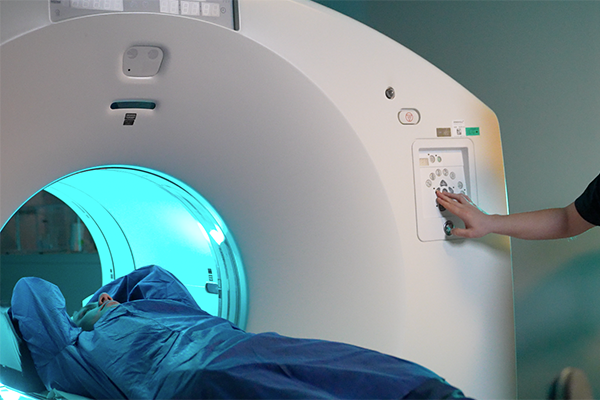
Radionuclide Treatments
Radionuclide treatments has shown high efficiency in the treatment of prostate cancer, neuroendocrine tumors of the gastrointestinal tract and pancreas. In particular, it gives very good results in advanced forms of oncology in the late stages with metastases and in the case when traditional methods, such as chemotherapy and radiation therapy, cannot help.
Radionuclide Treatments
Galiu-68 PSMA PET/CT
It is the most successful current imaging technology, which is used to detect the spread of the prostate cancer to other organs and tissues. The agent called PSMA, which is specific to prostate, is bound with gallium 68 radioisotope and intravenously administered to the patient who, in turn, is scanned with PET/CT. Gallium-68 PSMA bounds with some special molecules in prostate cancer cell to show the cancerous tissues. In this method, patients are not given high doses of radiation.
How is the Gallium-68 PSMA PET/CT procedure?
The examination needs to be planned a day in advance. Therefore, it is based on an appointment system. The drug is administered intravenously after which there is a waiting period of 45 to 60 minutes. The scanning in the device takes about 20 minutes during which the patient must hold still. A total time to be spent in Nuclear Medicine Department is 2 to 3 hours. Plenty of water is recommended to be drunk before and after the procedure. Patient must stay away from pregnant women and children as radiation will remain for a period of time (8 to 12 hours) after the procedure.
Gallium-68 DOTATATE PET/CT
It is the most advanced technology that may be used in diagnosing neuroendocrine tumours. Neuroendocrine tumour cells have a special receptor called “somatostatin” on their surfaces. DOTATATE is a compound having a structure of peptide that can bound to such receptors. When it is combined with the radioactive agent called “Gallium-68” and administered to the patient, PET/CT device can provide high precision images of the tissues with tumour cells. In this method, patients are not given high doses of radiation.
Lutetium-PSMA therapy
Lutetium -PSMA (177Lu-PSMA) therapy is a radionuclide treatment which has increasingly become used more frequently in the patients with advanced stage prostate cancer. The aim of the therapy is to reduce the size of the tumour and halt the proliferation of tumour cells. In this sense, both the progression of the disease is controlled and it becomes possible to alleviate the common advanced signs of the disease such as bone pain, fatigue etc. This therapy is used when the disease has advanced or spread. Moreover, it is used when the patient cannot tolerate the side effects of other therapies such as chemotherapy.
Lutetium-DOTATATE therapy
Lutetium-octreotide (177Lu-DOTATATE) therapy is a method of therapy which has become used more and more frequently in the patients with advance stage neuroendocrine cancer. It is also known as “Peptide receptor radionuclide therapy” (PRRT). The aim of this therapy is to reduce the size of the tumour and halt the proliferation of tumour cells. In this sense, both the progression of the disease is controlled and it becomes possible to alleviate the common advanced signs of the disease such as bone pain, fatigue etc. This therapy is used when the disease has advanced or spread or the patient cannot tolerate the side effects of the other therapies such as chemotherapy.
Actinium therapy
Ac-225 PSMA is the name of the radioactive agent administered to patient in targeted alpha therapy in prostate cancer. It is a therapy used in the patients with metastatic advance stage prostate cancer. The aim of the therapy is to reduce the tumour in size, halt the proliferation of and kill tumour cells. Radionuclide treatments are preferred when the disease progresses or spread or the patient cannot tolerate the side effects of the other therapies such as chemotherapy. As an overall approach, the first choice in the patients who are decided to be treated using a radionuclide treatment is lutetium PSMA therapy.
Lutetium-PSMA is a method of treatment which has been administered to thousands of patients both in the world and Turkey. The main goals of Lutetium-PSMA therapy include to relieve symptoms, extend life expectancy and improve the quality of life. However, in some patients, there may be no response to the lutetium-PSMA therapy and the disease may have a weak response to the therapy. Even, the disease may continue progressing in spite of the therapy. It has been shown on more and more patients in medical literature that in this group of patients, targeted alpha therapies using actinium-225-PSMA provides much better results.
Radium therapy
Radium therapy is the method of treatment used in the patients in which prostate cancer metastasize or spread to skeletal system and bones. The aim of this therapy is to destroy the cancer cells thus ensuring the tumours to be reduced in size or even disappear. In addition to its therapeutic effects, it is used to alleviate the pain caused by the metastases to bones.
Radionuclide Treatment Timeline
Lutetium (Lu-177) Treatment Schedule
Day 1:
Arrival to Turkey, airport pick-up, transfer to the hotel
Day 2:
Blood tests
Kidney Scintigraphy (generally done only on the first visit)
PSMA PET/CT (if necessary)
Nuclear Medicine Examination with Dr. Kezban Berberoglu
Day 3:
Lu-177 Treatment
Day 4:
Post-treatment scan
Evaluation of results with Dr. Kezban Berberoglu
**Generally lutetium patients can fly back 2-3 days after the treatment.
Actinium (Ac-225) Treatment Schedule
Day 1:
Arrival to Turkey, airport pick-up, transfer to the hotel
Day 2:
Blood tests,
Kidney Scintigraphy (generally done only on the first visit)
PSMA PET/CT (if necessary)
Nuclear Medicine Examination with Dr. Kezban Berberoglu
Day 3:
Ac-225 Treatment
**Generally actinium patients can fly back one day after the treatment.
Doctor Involved In: Kezban Berberoglu
Q&A
01 What is the essence of radionuclide therapy ?
In fact, this is a new kind of radiation therapy. Its peculiarity is that the radioactive substance that is injected into the patient intravenously accumulates in the tissues of the tumors, destroying them from the inside. Radiation attaches directly to cancer cells and very point-by-point, we can say, “sniper” destroys them without damaging healthy tissues of the body.
This method has shown high efficiency in the treatment of prostate cancer, neuroendocrine tumors of the gastrointestinal tract and pancreas. In particular, it gives very good results in advanced forms of oncology in the late stages with metastases and in the case when traditional methods, such as chemotherapy and radiation therapy, can not help. Since with radionuclide therapy, healthy organs and tissues are not damaged, patients do not have serious side effects, the quality of life is preserved, and its duration increases.
02 What is the purpose of Radionuclide Treatment?
03 How long have you been using radiation in the treatment of oncology ?
Our Department of Nuclear Medicine has extensive experience in the use of radioactive materials in the diagnosis of various diseases. For example, we actively apply our practice Technetium-99m and Fluoride-18. They are mixed with special agent substances, which are selected depending on the organ or diagnostic procedure. For example, bone scintigraphy uses agents that help radioactive particles accumulate in the bones. And in order to conduct a visual diagnosis of the tumor, a radiopharmaceutical based on glucose is used.
Until now, fluoride-18 in combination with glucose has been mainly used for PET-CT research, which is the “gold standard” in the treatment of oncology. However, it cannot be used to diagnose certain types of cancer, such as prostate cancer. Therefore, scientists came up with the idea of using in this case another radioactive material – Gallium-68 in combination with a special agent specific to the prostate.
Thanks to this, we have received a new, very effective type of diagnostics – PSMA PET CT, which allows us to visualize the tumor in the prostate with high accuracy, determine its volume and localization, the degree of development of the disease and, accordingly, choose the right and effective treatment. In the same way, we began to use Gallium-68 with a specific agent for the diagnosis of neuroendocrine tumors. Today, all these studies, which until recently seemed fantastic, are our routine practice.
Diagnostics with radioactive substances has become a very important part of radionuclide therapy: if we see that the tumor is susceptible to radioisotopes and is well visualized with their help, then we can in the same way direct a large dose of radiation for therapeutic purposes. In medicine, this direction was called “theranostics” (from the combination of the words “therapy” and “diagnosis”), and the drugs used are theranostic.
04 What radioactive substances are used in radionuclide therapy ?
We use two radioactive substances for the treatment of cancer – Lutetium-177 and Actinium-225. Actinium-225 affects the tumor through alpha radiation, and Lutetium-177 has beta radiation. Both of these radioisotopes are aimed at destroying the DNA of cancer cells, which leads to their death.
This treatment can be called “targeted radiotherapy.” Its greatest advantage is that the radioactive substance acts directly on the tumor, causing its death, without affecting the surrounding organs and tissues. It can be said that this is a new generation of treatment, which with sniper accuracy hits the “target” .
05 For which diseases do you most often use radionuclide therapy for treatment ?
06 When do doctors use this method ?
It is mainly used when chemotherapy and traditional radiation therapy can not help in the fight against cancer. However, radionuclide therapy can also be used in conjunction with other methods of treatment.
In our clinic, every oncological disease is handled by a multidisciplinary team of specialists: they jointly develop the most effective treatment plan, which may consist of several types of therapy. Doctors work together to decide whether to use radioisotope treatment and, if so, at what stage. That is, it would be wrong to say that this is the “last hope” for patients. We try to find the right treatment at the right time, which increases the chances of success in the fight against cancer.
07 How long does the treatment last ?
08 How safe is this method for the patient and others ?
9 How common is radionuclide treatment today ?
It is becoming increasingly popular as new scientific articles appear showing the high effectiveness of this method. But in many respects, its success depends on the experience and well-coordinated work of the medical team, on how correctly the treatment will be planned and carried out, whether its results will be monitored.
It is true that its use today is limited due to the fact that the necessary radioisotopes are produced in a small volume and not in all countries. Radionuclide treatment is available in few oncology centers around the world, and one of them is our clinic “Anadolu”.

